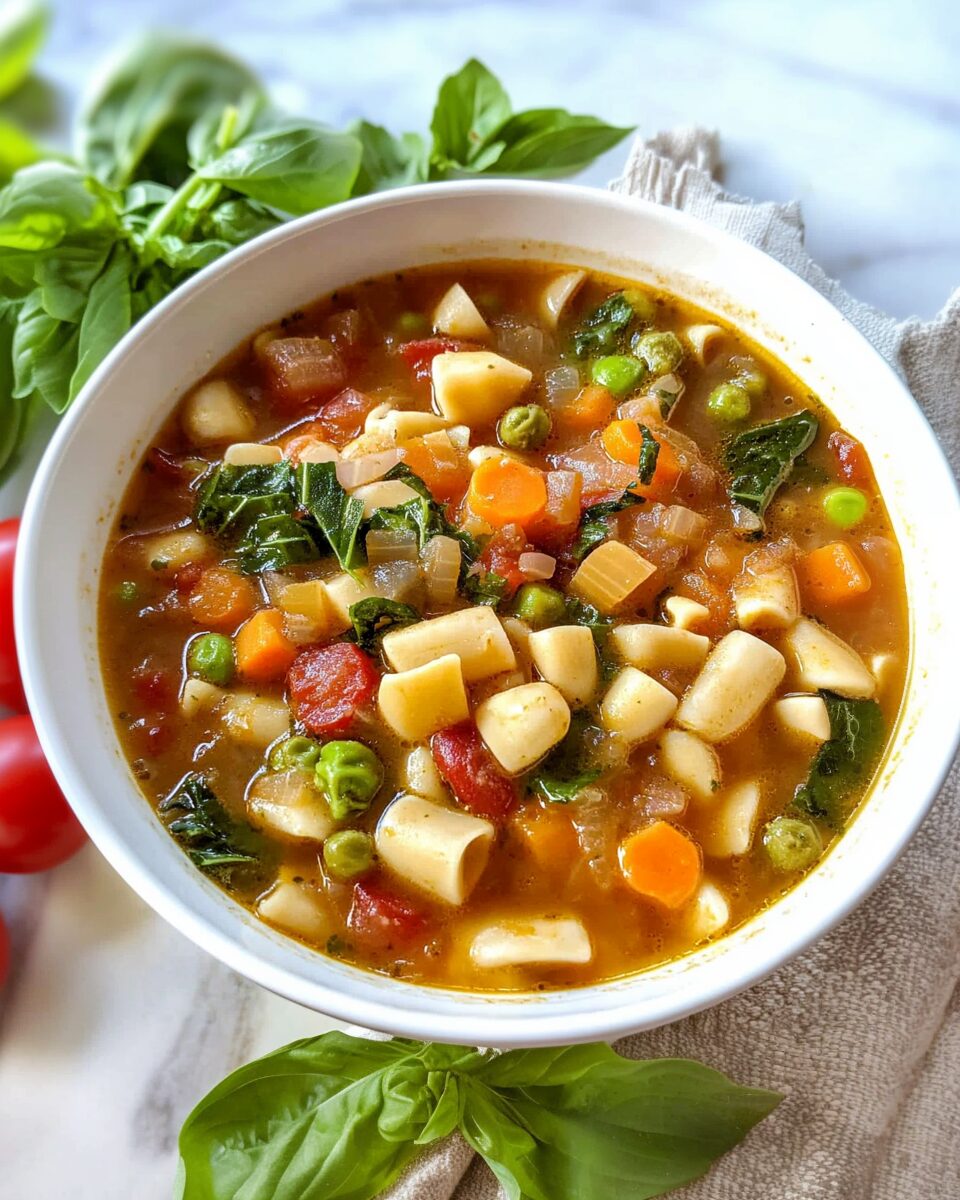Minestrone is the ultimate one-pot vegetable soup. A colorful, flavorful, and nutritious combination of seasonal vegetables, legumes, and herbs come together into one of the most iconic Italian dishes. Minestrone is comforting and satisfying, excellent for meal prep and a delicious family dinner.
Full Recipe:
Ingredients
- 2 tablespoons extra virgin olive oil
- 1 small onion, chopped
- 1 medium carrot, chopped
- 1 rib celery, chopped
- 1 leek, cut in half lengthwise, rinsed, and thinly sliced
- 3 cloves garlic, pressed
- 1 sprig rosemary
- 2 bay leaves
- 1 can (15 ounces) beans or 1½ cups cooked beans (borlotti, kidney, pinto, or cannellini)
- 2 medium potatoes (10 oz), diced
- 2½ cups cauliflower florets (10 oz)
- 2½ cups vine tomatoes (12 oz), diced
- 1½ cups frozen peas (7 oz)
- 1 cup ditalini pasta (5 oz)
- 1 medium zucchini (7 oz), chopped
- 4 cups water or vegetable broth
- 1½ teaspoons salt, or more to taste
- ¼ teaspoon black pepper
- 1 crust parmesan (optional; use only if from Parmigiano Reggiano or Grana Padano)
- ½ cup parmesan, shaved or grated
- 4 tablespoons basil pesto
- Fresh basil leaves for garnish
- Crusty bread
Directions
- Make Flavor Base: Heat 2 tablespoons extra virgin olive oil in a large pot. Add chopped onion, carrot, and celery. Stir in sliced leek and pressed garlic. Sauté for 5 minutes, stirring often.
- Cook Minestrone: Add diced potatoes, cauliflower florets, drained beans, rosemary sprig, and bay leaves. Pour in 3 cups of water. Season with salt and black pepper. Bring to a boil and simmer for 12 minutes, stirring occasionally.
- Add diced tomatoes, chopped zucchini, frozen peas, parmesan crust (if using), and ditalini pasta. Add 1 more cup of water and continue cooking for another 12 minutes, or until the pasta is cooked but still firm. Add more water to reach your desired consistency. Taste and adjust for salt. Turn off the heat and let the minestrone cool down for 5–10 minutes to allow the flavors to meld.
- Serving Tip: Place a thick slice of toasted crusty bread in a bowl. Cover the bread with grated parmesan cheese. Pour the hot minestrone over the bread and cheese. Garnish with shaved parmesan, a spoonful of basil pesto, and fresh basil leaves.
Nutrients
Per serving (with 2 teaspoons of basil pesto and a sprinkling of parmesan):
- Calories: 546 kcal
- Carbohydrates: 81 g
- Protein: 23 g
- Fat: 16 g
- Saturated Fat: 4 g
- Polyunsaturated Fat: 2 g
- Monounsaturated Fat: 6 g
- Cholesterol: 9 mg
- Sodium: 971 mg
- Potassium: 1558 mg
- Dietary Fiber: 15 g
- Sugar: 13 g
- Vitamin A: 5311 IU
- Vitamin B6: 1 mg
- Vitamin C: 104 mg
- Vitamin E: 2 mg
- Vitamin K: 65 µg
- Calcium: 293 mg
- Folate: 233 µg
- Iron: 5 mg
- Manganese: 2 mg
- Magnesium: 133 mg
- Zinc: 3 mg
History and Origins of Minestrone Soup
The term “minestrone” comes from the Italian word “minestra,” meaning soup, with the “one” suffix indicating that it is a large or abundant version. Minestrone is essentially a “big soup,” a hearty, filling dish designed to nourish a crowd. This humble meal was born out of necessity, as it was a way to use up leftover vegetables, beans, and grains that were commonly available to farmers and households across Italy. It wasn’t until the early 19th century that the dish began to resemble the modern version we know today.
Ingredients: A Celebration of Fresh, Seasonal Produce
The beauty of Minestrone soup lies in its flexibility. It can be made with virtually any vegetable that is in season, which makes it an adaptable dish throughout the year. The base of the soup typically includes a mix of onions, carrots, celery, and garlic, which are sautéed to form a flavorful foundation. From there, the ingredients can vary depending on the season and personal preferences.
In the spring and summer, fresh tomatoes, zucchini, and leafy greens such as spinach or kale might make an appearance, while in the fall and winter, root vegetables like potatoes, parsnips, and butternut squash are often used. Beans—such as cannellini, kidney, or borlotti—provide a hearty texture and a plant-based protein source, making the soup not only filling but also nutritious. Pasta, particularly short varieties like ditalini or elbow macaroni, can be added to give the soup more substance, though it can also be made without pasta for a lighter version.
The Nutritional Value of Minestrone Soup
One of the reasons Minestrone soup remains such a popular dish is its impressive nutritional profile. Packed with vegetables, legumes, and whole grains, Minestrone is a nutrient-dense meal that provides a wide array of essential vitamins, minerals, and fiber. Each bowl is an opportunity to consume a variety of different nutrients, making it an excellent choice for anyone looking to boost their daily intake of vegetables and plant-based foods.
The high fiber content of Minestrone soup comes from the vegetables and beans, which can help promote digestive health and regulate blood sugar levels. Additionally, beans are an excellent source of plant-based protein, making Minestrone a suitable meal for vegetarians and vegans. The inclusion of healthy fats from olive oil and optional parmesan cheese also contributes to the soup’s richness and satiating nature.
The Versatility of Minestrone Soup
One of the most appealing aspects of Minestrone soup is its versatility. While the traditional recipe calls for a specific set of vegetables and beans, the beauty of this dish lies in its adaptability. You can easily customize the soup to fit your personal preferences, dietary needs, or what you have on hand in your kitchen.
For instance, if you’re looking for a gluten-free version, simply omit the pasta or use gluten-free pasta. You can also make the soup entirely vegan by leaving out any cheese or using a plant-based cheese substitute. If you prefer a heartier soup, you can increase the amount of beans or add grains such as quinoa or farro. The soup can also be made in a slow cooker or pressure cooker for added convenience, allowing you to let the flavors meld together over time without much hands-on effort.
Minestrone Soup and Its Cultural Significance
Minestrone soup holds a special place in Italian culture and cuisine. It is often seen as a symbol of home-cooked comfort, representing the values of family, sustainability, and the importance of using locally grown, fresh ingredients. In Italy, Minestrone is typically served as a starter, although in other parts of the world, it is enjoyed as a main dish. It is often accompanied by crusty bread, which is used to soak up the flavorful broth.
Minestrone Soup Around the World
Although Minestrone soup originates from Italy, its popularity has spread far beyond the borders of the Mediterranean. The dish has been embraced in various countries, each putting its own spin on the traditional recipe. In the United States, for example, Minestrone is often made with a tomato-based broth and a variety of seasonal vegetables, and it is commonly served with a side of garlic bread. In the UK, the soup is sometimes made with a more substantial amount of pasta, making it a filling and satisfying meal.
Conclusion: Why Minestrone Soup Should Be in Your Recipe Rotation
Minestrone soup is more than just a delicious meal; it is a reflection of the Italian culinary tradition and a celebration of seasonal, fresh ingredients. Its rich history, versatility, and nutritional benefits make it an ideal dish for any occasion, whether you’re cooking for a crowd or preparing a cozy dinner for yourself. The beauty of Minestrone lies in its adaptability, allowing you to customize it to your liking and use whatever vegetables are in season.






